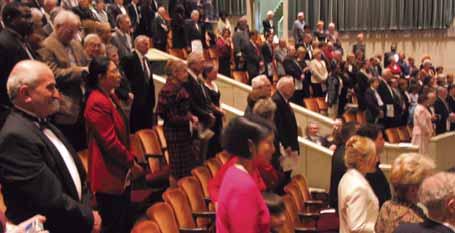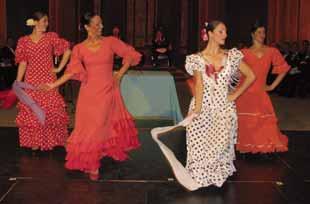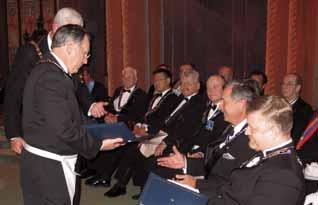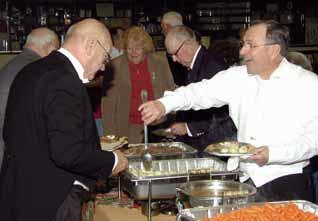
8 minute read
Grand Visitations — Legacy or Liability?
Have you ever attended a Grand Visitation? If so, what did you think of it? Was the experience enjoyable? Instructive? Motivating? Inspirational? How beneficial was it — to your lodge, your brethren, and to you? If given the opportunity, would you attend again?
Your response to these questions will undoubtedly reflect your recollection of events that occurred at the visitation that you attended. Moreover your answer will unquestionably be colored by your ongoing experiences, as a loyal Master Mason and, perhaps, as an officer, past or present, in your lodge or in the Grand Lodge.
The Grand Visitation is a procedure unique to Masonry in the District of Columbia. It was established in the third year of Grand Lodge Masonry in this jurisdiction, specifically on January 12, 1813, when the members of Grand Lodge resolved that it was the duty of the Grand Lodge officers “to visit, at least once a year, the different lodges under its jurisdiction, giving 10 days previous notice to the Master of the lodge they intend to visit.”
Eventually the substance of this resolution was integrated into the constitution of the Grand Lodge, where it now appears, in essentially identical form, as Section 22 of the Grand Lodge Code. That section of our law specifies that the “Grand Master shall make a grand visitation, attended by his officers, to the constituent lodges, at least once a year, ten days previous notice having been given to the Master of the Lodge.”
Such visitations by the Grand Master, usually with the officers of the Grand Lodge, have thus been a part of Masonry in this jurisdiction for 193 years. They did not begin immediately, however, and it was not until 1818 that the first of these visitations were actually made. Since then every Grand Master, in adherence to the will of Grand Lodge, has struggled to schedule his visitations in a manner that commands the favorable attention of the brethren generally.
While the Code obligates the Grand Master and his officers to make Grand Visitations, it does not stipulate when, how, or in what manner the visits are to be accomplished. These are details which have been left to the
Stewart W. Miner, Grand Secretary Emeritus
discretion of our Grand Masters for decision. As a result visitation schedules and substance have varied, the former, perhaps, more than the latter.
The visitation schedule was not an issue of any great consequence in the early years of the Grand Lodge when there were only a handful of lodges to visit. In 1825 the Grand Master completed his visits prior to the May 3rd Semi-Annual Communication. But as the number of lodges increased, scheduling became a more formidable issue, eventually inducing the Grand Lodge, in the year 1900, to move its annual communication to December in order to reserve October and November for Grand Visitations.
The proliferation of lodges over time raised another issue, particularly when the number of lodges increased to a total of 48. How could the Grand Master squeeze in visitations to lodges individually, within such a restricted period of time, and still attend to his other duties, Masonic and civil? He couldn’t, of course, and this naturally led to visitations in which a number of lodges, two, three, four, five, or all at once, as in 2005, were visited simultaneously.
In attempting to lessen the burden imposed by crowding the visitation schedule into a busy two-month period, several Grand Masters have attempted to break out of the October-November time frame by scheduling some visitations at other times of the year. In 1977, for example, Grand Master Brewer made his visits over the course of several months, starting in early March. Grand Master Chaney did likewise in 1996, and in 1997, Grand Master Drechsler scheduled two series of visitations, one in the Spring and another in the Fall.
In addition to confronting the issue of schedule, every Grand Master has been concerned with the structure of the Grand Visitation. Who does what and why? In 1818 Grand Master Daniel Kurtz stated that on his visits to the subordinate lodges that he examined the lodge books of proceedings, their methods of working, and that he had found the lodge records to be “fully, fairly, and correctly
kept.” He noted, however, that the modes of working in the lodges “was very dissimilar,” and that there were scarcely two lodges in the jurisdiction that “worked in the same manner.”
The interest patterns, as established by Grand Master Kurtz, have prevailed, by and large, from 1818 to the present. Over the years Grand Visitations invariably have been occasions for the formal review of work in the lodge; the examination of the lodge books of record; and the submission of reports on the work of the lodge Master, Secretary, and Treasurer. As the years rolled by other items were added to the agenda, including reports of the Grand Lecturer, the presentation of awards, and, without fail, a memorial prayer.
It became evident early on, however, that “business” alone would not long sustain the interest of the brethren at Grand Visitations. Thus, while the purposes of the visitation by the Grand Master and his officers have remained fairly constant, Grand Lodge leaders have striven to also make these occasions interesting and enjoyable by structuring them as festive occasions, complete with entertainment, Masonic instruction, and refreshments. Responsibility for making arrangements for the Grand Visitation has generally rested, in the past, on the leadership of the lodge or lodges being visited. When two or more lodges have been visited on the same evening, responsibilities usually have been divided and expenses shared. Under this arrangement the visited lodges provided entertainment and refreshments after the Grand Master had and his officers had sat in judgement of their Masonic efforts. On most occasions the Grand Master and his officers have been considered the guests of the lodges being visited and treated as such. Certainly this was the pattern of operation until 1869, the first of the two terms served by Grand Master Robert B. Donaldson. Intent on making the Grand Visitation an occasion of interest to the Craft generally, and not only to the officers of the visited lodges, Donaldson assumed responsibility for planning the visitation program.
Original Grand Visitation Band. (L to R): “Dutch” Albert,
“Skinny” Morris, Ralph Eshelmann, Robert Redding, Charles Weaver, Mike Easter, Robert Drechsler, Richard Weaver. June 1967. Brother Donaldson introduced music by inviting the participation of the Masonic Choir Association and by the presentation of lectures delivered by brethren invited to speak on Masonic subjects into his Grand Visitations Both of these innovations were enthusiastically accepted, and the new format of the Grand Visitation was used repeatedly for many years. It is interesting to note that in his attempt to create interest, Grand Master Donaldson really instituted the first Grand Lodge non-ritualistic edu
cation effort. The Donaldson-type of visitation lasted until 1883, when Grand Master Chamberlain returned the visitations back to their original form. At that time he decreed that lodge programs, on the occasion of the Grand Visitation, were to be arranged by the Master of the lodge being visited. They were, and this responsibility remained, by and large, until 2005, with Grand Masters usually bringing visitations to a close by delivering inspirational messages on
Masonic issues of personal choice.

Grand Lodge Awards Night. Masons, families, and friends gather in the Scottish Rite Temple for a ceremonial program replacing the traditional Grand Visitation.
Throughout the history of the Grand Lodge all of our Grand Masters have labored to maintain interest in the Grand Visitation. One such effort of note took place in 1941, when the Grand Lodge, under the leadership of Grand Master Ara M. Daniels, hosted what was termed the “First Annual Masonic Grand Visitation Banquet” at the Willard Hotel.
On that occasion more than 600 Masons shared dinner and enjoyed Masonic addresses delivered by U.S. Senator Chan Gurney of South Dakota and U.S.

Grand Lodge Awards Night. Spanish Dancers provided outstanding entertainment for those attending Awards Night.
Senator Harold H. Burton of Ohio, who later became an Associate Justice of the U.S. Supreme Court. While it was intended that this dinner would become an annual occasion thereafter, the practice was not continued because war-time conditions thereafter made such gatherings impractical.
The next significant modification of the Grand Visitation structure occurred in 1968, when for the first time a group of Almas Temple musicians, led by Brothers Eugene Albert and Elmer G. “Skinny” Morris, performed. At that time they provided marching music for the entrance and departure of the Grand Master and his suite, and at various interludes spiced up the evening by providing appropriate musical numbers. They continue to do so to this day.
In 2005 Grand Master Proden decided that it was time for a new look. While complying with the intent of the code, as he saw it, he purposely reversed the roles traditionally played by participants at these affairs. He did so by making the Grand Lodge and its officers the hosts of a gala visitation, in which the officers of the subordinate lodges and their families were received as guests.

Grand Lodge Awards Night. Grand Master and Deputy Grand Master present service certificates to Worshipful Masters.
It was an unusual affair, entirely devoid of the usual reports and judgements, formalities which were replaced by the presentation of awards and certificates of service, by bountiful refreshments, and by a rousing period of spine-tingling Spanish-style dancing. In contrast to the sparse attendance which had marked Grand Visitations in recent years, attendance at this one was exceptionally good.
Was the innovative visitation of 2005 enjoyable? Yes! Was it motivating? Yes! Was it inspirational? Yes! Was it instructive? Yes! Did it set a precedent for future Grand Masters to follow? No one knows, but that question will, in the fullness of time, be answered. In the meantime we may be certain that the innovative 2005 visitation demonstrated that anything is possible, given a mite of imagination. Grand Visitations, we now know, do not have to be anachronistic!

Traditional Grand Visitation. The sole traditional Grand Visitation in 2005 was to Anacostia Lodge No. 21, where the Grand Master enjoyed the evening.







